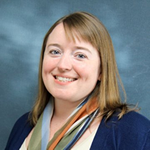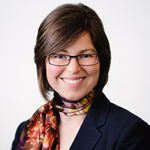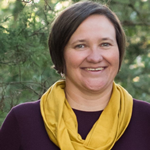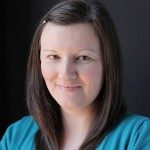Day 3 addressed collaborations and cooperative endeavors, and concluded the Exchange. Recordings of the presentations, plus the presenters’ slides and a transcription of the presentations, are available on the Exchange website. We encourage you to continue the conversation with the presenters by submitting comments and questions to their presentation pages on the website. The following summary is provided courtesy of Exchange Working Group member Marlee Givens.
Exchange Day 3: May 8, 2020. Collaborations and Cooperative Endeavors
Keynote: Keynote - Sustainable Thinking for the Future of Libraries: presented by Rebekkah Smith Aldrich
Described by Exchange Working Group Chair Kristin Martin as “uplifting,” this keynote celebrated the strengths of libraries as places of camaraderie, as catalysts for social engagement and change, and as conveners who bring the community together to act. Rebekkah Smith Aldrich, author of Sustainable Thinking: Ensuring Your Library’s Future in an Uncertain World, opened her keynote by talking about the world. During this time of disruption, complexity, and uncertainty on a global scale, she reminded attendees that we can respond through kindness and (in the words of her grandfather) taking care of each other.
Smith Aldrich urged attendees to consider “The Long Now,” and that the decisions made in this moment in time will impact generations to come. Quoting both Greta Thunberg and the United Nations Intergovernmental Panel on Climate Change, Smith Aldrich enumerated ways in which we can have the confidence to act, starting at the local level and taking a social approach. It is significant that ALA has adopted sustainability as one of its core values, and libraries have a role to play in the sustainability of their own communities. For example, the West Vancouver Memorial Library has adopted sustainability as a core value in its strategic plan, and the Santa Monica Public Library is a key player in that city’s Wellbeing Project.
We can embrace the concepts of “hopepunk” and the triple bottom line as we take care of our library workers, increase practices of sustainability, and demand a kinder world. Smith Aldrich called on attendees to broaden our cultural competence and focus on inclusivity. She invited them to “library science the shit out of this.” As the executive director of a network of sixty-six public libraries, she shared stories from these and other libraries that are responding to their communities in novel ways, both before and during the current Covid-19 pandemic. Initiatives range from on-site efforts like 3D printing of PPE, repair cafes, and self-sufficiency programs, to community outreach like block parties and picnics. They include social media outreach and offline outreach like calling community members to check on them. One innovative library added local experts (like beekeepers) to its catalog. Another allowed local youth to take over their youth programming after a group of young people asked for a space “to make the world suck less.”
Lastly, during the Q&A, Smith Aldrich reminded us that while libraries are non-partisan, we are not neutral. We must be politically aware, but we can also reach both sides of an issue and find common ground. She concluded by encouraging us to learn more about sustainable buildings.
Using Project Management Principles to Ensure Successful Collaboration: presented by Jami Yazdani
Experienced project manager and Founder and Chief Strategist of Yazdani Consulting and Facilitation, Jami Yazdani explained the principles of project management as a framework for creating and working toward a shared vision, and to address the question “what does success look like?” Project management principles of scope, deliverables, schedule and communication can contribute to a shared vision and help a project team complete its work and measure its success.
Scope gives the project team its purpose and focus, and Yazdani recommended that teams use a well-defined scope to achieve buy-in and consensus. Consensus is a shared vision of success, reached through a shared agreement and willingness to accept the plan to move forward. Deliverables define what the team wants to accomplish and guide the team’s work through actionable tasks. Scope and deliverables should be documented for transparency and trust. A schedule sets realistic and specific, though flexible, expectations for when deliverables are due and when the project will have achieved success. Communications define what internal and external stakeholders need to know and when. Successful project teams set clear expectations about communication and allow for feedback.
Yazdani offered suggestions for using project management principles for committee work and meetings. Committees can set goals and use agendas and timelines to set expectations. They can manage scope by using a parking lot or idea board to save ideas for another time. They can also document accomplishments. Meeting agendas should define the purpose (even something as simple as discuss X, decide on Y) and goals of the meeting. Attendees can manage meetings without agenda or scope by asking questions, using key phrases like “just to make sure I’m clear” when summarizing decisions and recording action items, and asking for deadlines.
The presentation ended with recommendations for collaborating during the pandemic, when many of us are working remotely. This may be a time to think broadly about the collaboration, review the scope and deliverables, reconsider the vision of success, and revise the project as necessary. It’s also a time to focus on the quality of communication, allow for discussion, invite feedback and inquiry through tough questions, and to feel okay with asking for more time.
Making Connections through Campus Collections: presented by Susan Ponishchil
Susan Ponishchil was the new Metadata & Resource Discovery librarian at Grand Valley State University (GVSU) Libraries, when she was presented with a problem: managing the inventory of small focused collections belonging to campus partners outside the library, which are indexed in the library catalog. She learned about practices, identified contacts, and developed a plan to prioritize solutions to the issues she uncovered. She wrote a Memorandum of Understanding (MOU) outlining the responsibilities of the library and the campus partners in tracking inventory for these collections. She also worked with her colleagues to more adequately describe the location of items in these collections.
Due to Ponishchil’s success, as she defined it, “word got out,” and new partners approached the library to add their collections. She’s currently working on additional refinements to the management of these small, unique collections, including ensuring that these items circulate in their locations and are not lent through interlibrary loan, and using templates to streamline transportation of items through campus mail. She’s also investigating an inventory tool provided by Institutional Marketing at GVSU that could potentially track use counts. She finished her presentation with an interactive sequencing exercise to help participants consider what steps they might take to pursue a similar project.
Cultivating Tolerance through Conversation: Creating an Inclusive Community at Your Library: presented by Caroline Dulworth
Unfortunately, this presentation did not take place during the live event, and will be recorded and available on the Exchange website.
Beyond "OK, Boomer": Understanding Today's Intergenerational Workplace Cultures in the Library: presented by Raymond Pun, with panelists Sarah Dallas, Eboni Henry and Jahala Simuel
The panelists provided their perspective in response to several provocative questions about the different generations (Traditionalist, Baby Boomer, Generation X, Millennial and Generation Z) who are employed in or use our libraries. They engaged the audience through polls to ask what words come to mind when we hear these labels. Pun then shared word clouds that showed characteristics from recent publications about the generations.
Following question prompts from moderator Pun, panelists considered several aspects of generational differences and divides, and offered their experience and advice as supervisors in libraries. Staff in all generations can play a role in reviewing library services, cross-training and team building, and offering creativity, skills and strengths. Supervisors can offer a safe space for dealing with conflict, listen with respect, lead by example, recognize the value of staff, and put people first. The ideal intergenerational workplace provides professional development opportunities, transparency in communications, data-based decision-making, and especially at this time, making the mental and physical health of its staff a priority. Some particular recommendations included celebrating staff, setting norms for virtual meetings, having fun activities and sharing pictures, and (when in the office) having food-based events where people can share about their culture.
The chat was lively and also multigenerational. Some questions and answers included recommendations on how to get to know staff and to treat everyone as an individual, to move away from using labels and to strengthen cultural competence, and to focus on the strengths and skills that each person brings to work rather than stereotyping based on generation. Pun summarized the conversation by stating that there’s not one right way of doing things.
This was the final session of the Exchange, and session moderator Susan Davis thanked participants for sticking through to the end. She also thanked Mike Morneau from LearningTimes, who handled technical arrangements. In closing, Davis reminded attendees about the upcoming CORE Virtual Forum, which will take place November 18 and 20, 2020. She added that attendees would receive an evaluation, and the discussion forums will remain open through next week.




 Emily Nimsakont is the Cataloging and Metadata Trainer at Amigos Library Services. She’ll present the session “Documenting Library Work: Lessons We Can Learn from Technical Writers” on May 6 at 2:15 p.m. EDT. Her guest blog post follows.
Emily Nimsakont is the Cataloging and Metadata Trainer at Amigos Library Services. She’ll present the session “Documenting Library Work: Lessons We Can Learn from Technical Writers” on May 6 at 2:15 p.m. EDT. Her guest blog post follows.  Steven J. Bell is the Associate University Librarian for Research and Instructional Services at Temple University. He’ll present the session “3 C’s for Leading Community Engagement Initiatives in Academic Libraries” on May 4, 3:25 p.m. EDT. His guest blog post follows.
Steven J. Bell is the Associate University Librarian for Research and Instructional Services at Temple University. He’ll present the session “3 C’s for Leading Community Engagement Initiatives in Academic Libraries” on May 4, 3:25 p.m. EDT. His guest blog post follows. Cinthya Ipololiti, Director and University Librarian, University of Colorado, Denver, will present the session “Managing Change from the Inside-Out: The Library as Catalyst for Transformational Change” on May 4, 12:45 at 1:25 p.m. EDT. Her guest blog post follows.
Cinthya Ipololiti, Director and University Librarian, University of Colorado, Denver, will present the session “Managing Change from the Inside-Out: The Library as Catalyst for Transformational Change” on May 4, 12:45 at 1:25 p.m. EDT. Her guest blog post follows. Emily Drabinski is the Interim Chief Librarian at the Graduate Center, City University of New York. She’s also the liaison to the School of Labor and Urban Studies and other CUNY masters and doctoral programs. Her research includes critical approaches to information literacy instruction, gender and sexuality in librarianship and the intersections of power and library systems and structures. Ms. Drabinski is one of the keynote speakers for the Exchange. Her address is titled “Making Power, Making Change,” and will take place on Monday, May 4, 2020, at 12:10 p.m. EDT.
Emily Drabinski is the Interim Chief Librarian at the Graduate Center, City University of New York. She’s also the liaison to the School of Labor and Urban Studies and other CUNY masters and doctoral programs. Her research includes critical approaches to information literacy instruction, gender and sexuality in librarianship and the intersections of power and library systems and structures. Ms. Drabinski is one of the keynote speakers for the Exchange. Her address is titled “Making Power, Making Change,” and will take place on Monday, May 4, 2020, at 12:10 p.m. EDT.